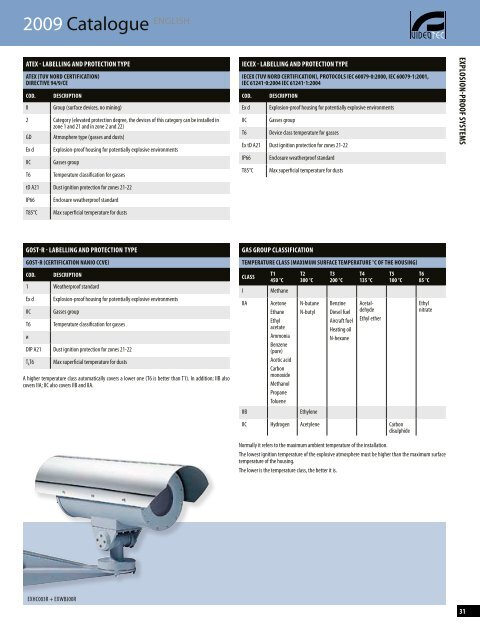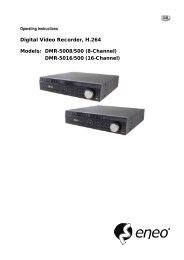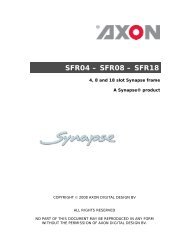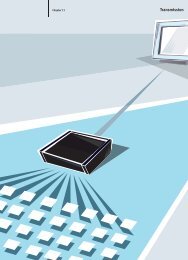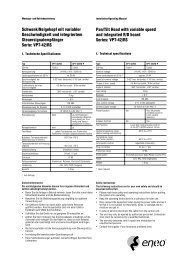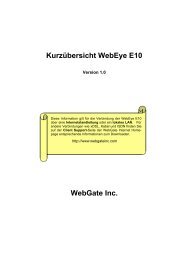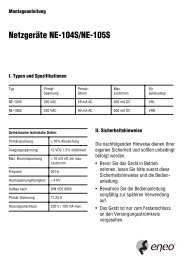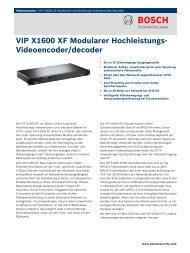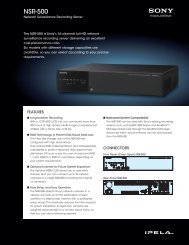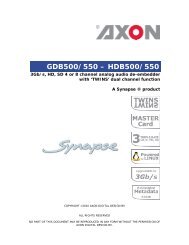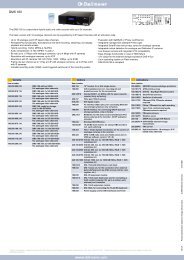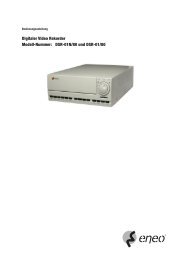Videotec Catalogue (pdf) - Videor
Videotec Catalogue (pdf) - Videor
Videotec Catalogue (pdf) - Videor
Create successful ePaper yourself
Turn your PDF publications into a flip-book with our unique Google optimized e-Paper software.
2009 <strong>Catalogue</strong> english<br />
ATEx - LABELLiNg AND PROTECTiON TYPE<br />
ATEx (TuV NORD CERTiFiCATiON)<br />
DiRECTiVE 94/9/CE<br />
COD. DEsCRiPTiON<br />
II group (surface devices, no mining)<br />
2 Category (elevated protection degree, the devices of this category can be installed in<br />
zone 1 and 21 and in zone 2 and 22)<br />
gd Atmosphere type (gasses and dusts)<br />
Ex d Explosion-proof housing for potentially explosive environments<br />
IIC gasses group<br />
T6 Temperature classification for gasses<br />
td A21 dust ignition protection for zones 21-22<br />
Ip66 Enclosure weatherproof standard<br />
T85°C Max superficial temperature for dusts<br />
gOsT-R - LABELLiNg AND PROTECTiON TYPE<br />
gOsT-R (CERTiFiCATiON NANiO CCVE)<br />
COD. DEsCRiPTiON<br />
1 Weatherproof standard<br />
Ex d Explosion-proof housing for potentially explosive environments<br />
IIC gasses group<br />
T6<br />
и<br />
Temperature classification for gasses<br />
dIp A21 dust ignition protection for zones 21-22<br />
TAT6 Max superficial temperature for dusts<br />
A higher temperature class automatically covers a lower one (T6 is better than T1). In addition; IIB also<br />
covers IIA; IIC also covers IIB and IIA.<br />
ExhC003R + ExWBJ00R<br />
iECEx - LABELLiNg AND PROTECTiON TYPE<br />
iECEx (TuV NORD CERTiFiCATiON), PROTOCOLs iEC 60079-0:2000, iEC 60079-1:2001,<br />
iEC 61241-0:2004 iEC 61241-1:2004<br />
COD. DEsCRiPTiON<br />
Ex d Explosion-proof housing for potentially explosive environments<br />
IIC gasses group<br />
T6 device class temperature for gasses<br />
Ex td A21 dust ignition protection for zones 21-22<br />
Ip66 Enclosure weatherproof standard<br />
T85°C Max superficial temperature for dusts<br />
gAs gROuP CLAssiFiCATiON<br />
TEMPERATuRE CLAss (MAxiMuM suRFACE TEMPERATuRE °C OF ThE hOusiNg)<br />
CLAss<br />
T1<br />
450 °C<br />
T2<br />
300 °C<br />
I Methane<br />
IIA Acetone n-butane<br />
Ethane<br />
Ethyl<br />
acetate<br />
Ammonia<br />
Benzene<br />
(pure)<br />
Acetic acid<br />
Carbon<br />
monoxide<br />
Methanol<br />
propane<br />
Toluene<br />
n-butyl<br />
IIB Ethylene<br />
T3<br />
200 °C<br />
Benzine<br />
diesel fuel<br />
Aircraft fuel<br />
heating oil<br />
n-hexane<br />
T4<br />
135 °C<br />
Acetaldehyde<br />
Ethyl ether<br />
T5<br />
100 °C<br />
IIC hydrogen Acetylene Carbon<br />
disulphide<br />
T6<br />
85 °C<br />
Ethyl<br />
nitrate<br />
normally it refers to the maximum ambient temperature of the installation.<br />
The lowest ignition temperature of the explosive atmosphere must be higher than the maximum surface<br />
temperature of the housing.<br />
The lower is the temperature class, the better it is.<br />
ExPLOsiON-PROOF sYsTEMs<br />
31


